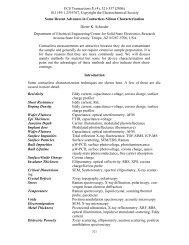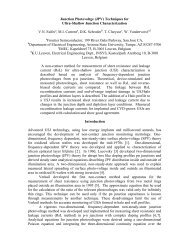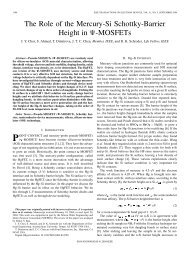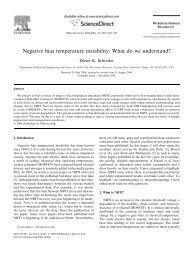Surface voltage and surface photovoltage - Dieter Schroder ...
Surface voltage and surface photovoltage - Dieter Schroder ...
Surface voltage and surface photovoltage - Dieter Schroder ...
Create successful ePaper yourself
Turn your PDF publications into a flip-book with our unique Google optimized e-Paper software.
<strong>Surface</strong> <strong>voltage</strong> <strong>and</strong> <strong>surface</strong> photo<strong>voltage</strong><br />
<strong>and</strong> by Goodman in 1961 [8]. It was Goodman’s SPV approach<br />
that led to the first full-scale implementation of the technique<br />
in the semiconductor industry at RCA [9]. It was employed<br />
during semiconductor production by inserting high diffusion<br />
length wafers into critical furnaces <strong>and</strong> measuring the diffusion<br />
length after heating the wafers to characterize the cleanliness<br />
of these furnaces. Through this relatively simple, contactless<br />
method, they were able to determine cracked furnace tubes,<br />
contaminated solid source diffusion sources, metallic contact<br />
contamination <strong>and</strong> other contamination sources.<br />
Instead of dc <strong>surface</strong> <strong>voltage</strong> or photo<strong>voltage</strong> measurements,<br />
lifetimes or diffusion lengths can also be extracted<br />
from frequency-dependent, charge-based measurements.<br />
Nakhmanson was one of the first to introduce<br />
frequency-dependent optically induced lifetime measurements<br />
[10]. The equivalent circuit concept has proven to be<br />
very powerful for the analysis of such measurements. Some of<br />
the earliest papers dealing with equivalent circuits are due to<br />
Lehovec <strong>and</strong> Slobodskoy [11] <strong>and</strong> Hofstein <strong>and</strong> Warfield [12].<br />
During charge-based measurements, charge is deposited<br />
on the wafer <strong>and</strong> the semiconductor response is measured by<br />
one of several techniques, from a corona source or through a<br />
chemical rinse. To underst<strong>and</strong> charge-based measurements, it<br />
is necessary to underst<strong>and</strong> Kelvin probe measurements, first<br />
proposed by Kelvin in 1881 [13]. Kronik <strong>and</strong> Shapira give an<br />
excellent review of such probes <strong>and</strong> their various applications<br />
[14]. A Kelvin probe is usually operated as a vibrating probe<br />
with minimization of the external current. The probes in some<br />
characterization instruments are not vibrating <strong>and</strong> we will refer<br />
to such probes as <strong>surface</strong> <strong>voltage</strong> probes.<br />
The energy b<strong>and</strong> diagram of the probe–air–semiconductor<br />
system is analogous to that of an MOS capacitor with the<br />
insulator replaced with air. Positive charges, deposited on<br />
the semiconductor <strong>surface</strong>, deplete the <strong>surface</strong> of the p-type<br />
sample. Photons, incident on the sample, generate excess<br />
carriers within the space-charge region <strong>and</strong> in the quasineutral<br />
bulk region. The electrons within the scr <strong>and</strong> within a<br />
distance of approximately the minority carrier diffusion length<br />
from the edge of the scr are collected in the space-charge<br />
region <strong>and</strong> reduce the <strong>surface</strong> potential barrier. The barrier<br />
lowering is similar to a forward-biased junction <strong>and</strong> the probe<br />
detects the difference of the quasi-Fermi levels. For high-level<br />
injection, the <strong>surface</strong> potential vanishes <strong>and</strong> the probe achieves<br />
its maximum potential [15].<br />
3. <strong>Surface</strong> charging<br />
A crucial component for charge-based measurements is the<br />
<strong>surface</strong> treatment to create the <strong>surface</strong> space-charge region.<br />
Two options are available: treat the <strong>surface</strong> chemically or<br />
deposit corona charge. During chemical treatment, for n-type<br />
silicon, the oxide on the sample <strong>surface</strong> should removed <strong>and</strong><br />
then the sample should be boiled in H 2 O 2 or in water for<br />
about 15 min <strong>and</strong> then rinsed in deionized water (DI) [16].<br />
Alternately, one can soak the sample in KMnO 4 for 1–2 min<br />
<strong>and</strong> then rinse in DI water. These treatments produce a stable<br />
depletion <strong>surface</strong> potential barrier. For p-type silicon very little<br />
treatment is required. In the case of very low V SPV , etching in<br />
buffered HF followed by a DI water rinse is recommended.<br />
+<br />
5 – 10 kV<br />
Semiconductor Wafer<br />
Wafer Chuck<br />
Figure 1. Schematic illustration of a point electrode corona<br />
charging method. The deposited charge is precisely measured with<br />
the operational amplifier charge meter.<br />
Corona charging is a second method of depositing charge<br />
on a <strong>surface</strong>. It is most commonly used in copying processes<br />
using xerographic techniques where the charge is deposited on<br />
a photoconductive drum [17]. One of the first uses of deposited<br />
charge in the field of semiconductors was by Williams <strong>and</strong><br />
Willis in the characterization of ZnO in 1968 [18]. Williams<br />
<strong>and</strong> Woods [19] <strong>and</strong> Weinberg [20] later exp<strong>and</strong>ed the approach<br />
to the characterization of oxide leakage current <strong>and</strong> mobile<br />
charge drift [21]. The method consists of the deposition of<br />
ions on a <strong>surface</strong> at atmospheric pressure through an electric<br />
field applied to a source of ions. The corona source consists of a<br />
wire, a series of wires, a single point or multiple points located<br />
a few mm or cm above the sample <strong>surface</strong> [22]. The substrate<br />
may be moved during charging or between charging cycles <strong>and</strong><br />
the sample may be charged uniformly or in well defined areas<br />
through a mask arrangement. It is even possible to deposit positive<br />
(negative) charge in a given area <strong>and</strong> surround the area with<br />
negative (positive) charge, to act as a guard ring [23]. In contrast<br />
to metallic guard rings that always contain a gap between<br />
the two electrodes, a corona charge guard ring has zero gap.<br />
A potential of 5000–10 000 V of either polarity is applied<br />
to the corona source, as illustrated in figure 1. Ions are<br />
generated close to the electrode, where a faint glow may<br />
be observed in a darkened room. For a negative source<br />
potential, positive ions bombard the source while free electrons<br />
are rapidly captured by ambient molecules to form negative<br />
ions. For a positive source potential, electrons are attracted<br />
to the source <strong>and</strong> positive ions follow the electric field lines<br />
to the substrate. The negative <strong>and</strong> positive corona ionic<br />
species are predominantly CO 3− <strong>and</strong> H 3 O + (hydrated protons),<br />
respectively. The corona source forces a uniform flow of<br />
ionized air molecules toward the <strong>surface</strong>. The very short<br />
(approximately 0.1 µm) atmospheric mean free path of the<br />
ionized gas ensures collision-dominated ion transport with the<br />
molecules retaining very little kinetic energy. The charge is<br />
not permanent <strong>and</strong> can be removed by a water rinse. Typically<br />
a few seconds are required to charge an insulating <strong>surface</strong> to a<br />
saturation potential.<br />
One of the advantages for oxide thickness <strong>and</strong> oxide<br />
integrity measurements using corona charge ‘gates’ rather than<br />
conductive gates is the low <strong>surface</strong> mobility of the ‘corona’ ions<br />
on the sample <strong>surface</strong>. A charge deposited on the <strong>surface</strong> of<br />
an oxidized wafer, creates an oxide electric field. The oxide<br />
will break down at its weakest spot, with the current confined<br />
to the breakdown spot, because the <strong>surface</strong> corona charge does<br />
R17








